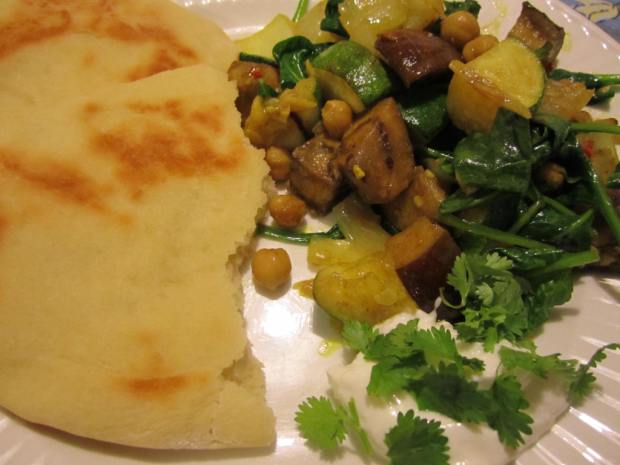I have a confession to make: I LOVE bread. I’m not even picky but the ethnic kinds are especially hard for me to resist. French, Ciabatta, Bolillos….you name it, I’m eating it! And don’t get started on how bread is bad for you, refined grains, yadda yadda yadda. La la la la la…I’m not listening! Ha! The following recipe is a bread from India that is eaten with nearly every meal. And yes, it qualifies as awesome.
Naan is a leavened flatbread from India. Although we don’t typically see naan in the grocery (unless you are shopping at an ethnic grocer), it is super easy to make. Naan makes a wonderful accompaniment to soups, stews and ragouts as it is easily torn and can be used as a scoop. And did I mention it’s delicious? The following recipe is modified as I didn’t want to go through the trouble of making clarified butter (a common Indian recipe ingredient). I substituted EVOO with excellent results.
Naan (Indian Flatbread) Makes 8
1 1/2 teaspoon dry yeast
1 cup warm water
1 1/2 teaspoon sugar
3 cups all-purpose flour, plus extra to work the dough.
1 teaspoon salt
3 tablespoons EVOO, plus extra for oiling the pans
3 tablespoons plain yogurt
In a large bowl, add the dry yeast, sugar and water and stir. Let this mixture set for up to 30 minutes or until the mixture starts to foam. this indicated the yeast is alive and your bread will actually rise. If you get zero foaming action, toss the whole thing out, get new yeast from the store and start over.
After the mixture starts to foam, add the salt, EVOO and yogurt. Stir to combine. Add 2 cups of the four into the water-yeast mixture and stir to start to combine. (I use a large serving fork. Works great!) The mixture is going to be sticky and lumpy. Add the last cup of flour and continue stirring. The mixture will become stiffer and likely more lumpy which is normal.
On a clean counter or work surface, pour approximately 1/2 cup of additional flour and dump out the dough into the middle of the pile of flour. Stop and clean the bowl thoroughly and pour a few teaspoons of EVOO into the bottom of the clean bowl. Using your clean, and now greasy olive oil covered hands, start to knead the dough. You’ll notice the dough is still somewhat sticky and it will be picking up much of the flour you added to the counter. Continue kneading the dough, adding flour as necessary, for about 10 minutes, or until the dough starts to become more elastic and stretchy. Put the ball of dough into the pre-greased bowl, turning the dough over so all sides are covered in a smidge of olive oil, and set aside to rise.
Food Fact Moment: What is the purpose of kneading? Kneading does two things- it thoroughly distributes the ingredients, and more importantly, it develops the protein strands (gluten) giving the bread its structure. Bread flour has a greater percentage of gluten and thus gives the resulting product more “firmness” or stability. Pastry flour has a very low percentage of gluten resulting in a tender, flaky product perfect for pie crusts and cakes. All-purpose flour has a protein/gluten content somewhere between the two. For this reason, if you are using all-purpose flour like I do, you will have to knead the dough a bit longer so the protein has the maximum opportunity to develop and your bread won’t turn out all crumbly and falling apart. How do you know when to quit? Either the dough starts to get “springy” or your arms get tired. Fortunately they both happen around the same time. 🙂
While waiting for the dough to rise, prep two large baking sheets. Line each with foil and grease the surface with EVOO. Set aside. Preheat the oven to 400 degrees.
After the dough has doubled in size- roughly an hour to an hour-and-a-half- punch down the dough and divide into eight portions. they don’t have to be perfect. Taking one portion at a time, onto a floured work surface, roll the dough ball out to a flat disk approximately 1/4″ to 3/8″ thick. The disks will be about 7″ across and have irregular sides. Place on the prepped baking sheets. The sides may touch but try to give them each a little breathing room. Lightly brush the tops of the bread with a little bit of EVOO and place into the hot oven, one tray in the middle of the oven and one at the top. Bake for 5 minutes and rotate the pans from front to back and top to bottom. Bake 5 more minutes and flip each naan over and brush with additional EVOO. You will notice the rack on the bottom will get brown first so move the baking sheets around accordingly so each pan browns evenly and each side browns evenly as well. This is not a time to check your email. A kitchen timer is your friend. When the naan are gently browned on both sides, remove from oven and serve hot. I freeze the leftovers as I can’t eat it all in one sitting. Thaw at room temperature. Reheated by wrapping in aluminum foil and placing in a 250 degree oven for 5 minutes.



Heidi @ lightlycrunchy
I love naan – I used to have a roommate that would make it. We can buy it frozen in the grocery store, but I could give this a try.
Kathryn
🙂
Fresh bread. Fresh bread. It’s calling your name. lol